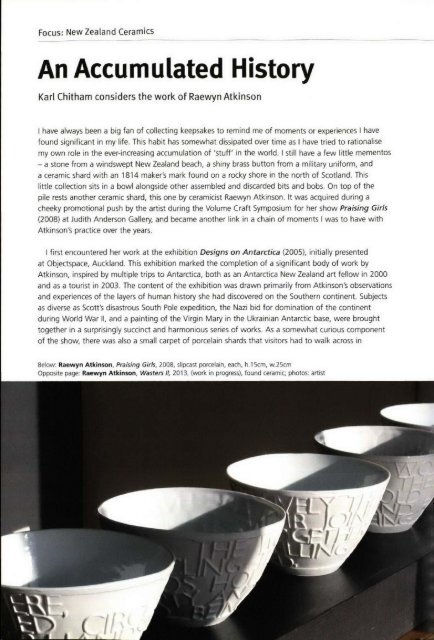The Journal of Australian Ceramics Vol 52 No 1 April 2013
Create successful ePaper yourself
Turn your PDF publications into a flip-book with our unique Google optimized e-Paper software.
Pr<strong>of</strong>ile<br />
In a foray away from Tasmania he spent time in and around another mining area, Broken Hill,<br />
producing a large body <strong>of</strong> work, Heartlands. This was his first extended encounter with the arid<br />
interiors <strong>of</strong> Australia that had so taxed the early explorers. Vincent conducted an intense dialogue<br />
with, and an artistic post-mortem <strong>of</strong>. the very body <strong>of</strong> the terrain. At a sweeping glance, his clay forms<br />
appear like a trove <strong>of</strong> large shards literally sliced from rock faces or scooped from the desert's surface. A<br />
crusty thick impasto spread with gusto, alongside sumptuous textural segments with sliced and gouged<br />
linear passages create a rich palette out <strong>of</strong> the seemingly sterile monochromatic spaces <strong>of</strong> the region.<br />
Here the ruggedly cleaved shards with their fissured and cracked surfaces echo the processes that<br />
formed the outback eons ago. This inland region saw the artist's meanderings lead to a kind <strong>of</strong> ultimate<br />
confrontation with the very heart <strong>of</strong> the matter. His next project led him further into the parched stony<br />
wilderness. <strong>The</strong>re resulted a large installation work, Interior, which was Vincent's personal interpretation<br />
<strong>of</strong> some <strong>of</strong> the sites that Charles Sturt recorded on his final epic, but ultimately disillusioned, journey.<br />
<strong>The</strong>se bodies <strong>of</strong> work coaxed and manipulated by the artist from base clay, made the ordinary<br />
extraordinary and were the apogee <strong>of</strong> his explorations. Like a biblical character, Vincent was looking to<br />
find redemption from the failings <strong>of</strong> the past to resurrect a new <strong>Australian</strong> post-colonial identity and<br />
attitude towards the landscape.<br />
Vincent's poetic dialogue with the landscape as an explorer, recorder and cartographer produced a<br />
vast amount <strong>of</strong> reference points, grid maps and snapshots on ceramics for the viewer to contemplate.<br />
Vincent McGrath, <strong>The</strong> Blister, earthenware<br />
h.SOcm, w.2Scm, d.SOcm<br />
Vincent McGrath. Queenstown Legacy<br />
h.81cm, w.31cm, d.23cm<br />
20 THE JOURNAL OF AUSTRALIAN CERAMICS APRIL <strong>2013</strong>

















